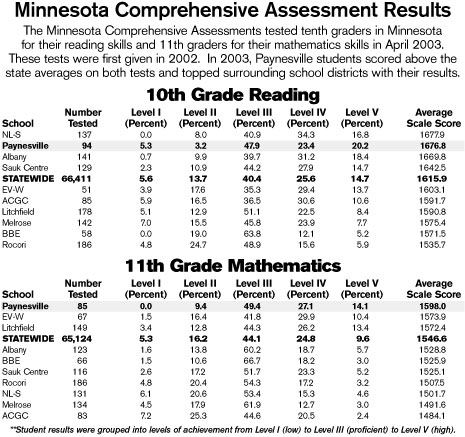Students ace reading, math tests
 Paynesville Area High School scored above state averages - and near the top in central Minnesota - in the Minnesota Comprehensive Assessments in math and reading.
Paynesville Area High School scored above state averages - and near the top in central Minnesota - in the Minnesota Comprehensive Assessments in math and reading. Minnesota juniors took the mathematics test, and sophomores statewide took the reading test in April. The results from both tests were released in July by the Department of Education.
In mathematics, PAHS had an average score of 1598.0, surpassing the state average of 1546.6, and over 91 percent of juniors at PAHS showed proficiency in mathematics by scoring in Levels III, IV, and V.
Students are ranked into levels of achievement, based on their scores, ranging from Level I (low ability) to Level III (proficient) to Level V (high ability).
"We did quite well, but I would caution people that it's only one test. It's only one indicator, but it's obviously a good one," said high sch
"I guess the credit goes to the junior class," said Brinkman. "They're the ones who work hard."
PAHS juniors ranked the highest among ten surrounding school districts on the mathematics test. (See chart on page 2.) They also ranked second among 26 schools in the St. Cloud area, according to a graph compiled by the St. Cloud Times. Among the schools that the Times compared, only Monticello had a higher average score in math.
PAHS sophomores also ranked second in the Times' comparison. Only Swanville bettered PAHS sophomores' reading results. PAHS also was second in reading among ten surrounding school districts, being topped only by New London-Spicer. (See chart on page 2)
Among the ten school districts surrounding Paynesville, only four topped state averages on the tenth grade reading test, and only three did so on the mathematics test. PAHS was the only school to top state averages on both tests.
PAHS sophomores had an average score of 1676.8, exceeding the state average of 1615.9.
High school principal John Janotta called the test results "very good news," and principal Deb Gillman, who is also the district's curriculum coordinator, said students and staff did a fabulous job.
Brinkman credits the math results to two things: good students and students who take a lot of math. Of this year's junior class, he estimates two-thirds will take three years of high school math: algebra, geometry, and trigonometry.
Statewide, results of the 11th grade Minnesota Comprehensive Assessment in math show that more math taken means better scores.
Taking three years of high school math exposes students to all the concepts on the test, according to Brinkman. In two years of taking the test, his trigonometry students have never asked him, "What was that?" At most, they might say, "Gosh, I couldn't remember how to do that."
Students take so much math because of a community awareness that education, and mathematics, is important, said Brinkman.
All PAHS juniors did well on the math test. PAHS had the enviable distinction to have no juniors in the lowest level in mathematics.
That may be because even PAHS students who opt not to take the college-prep math sequence of algebra, geometry, and trigonometry, still get exposed to many of the concepts. The two-year tech math sequence includes three quarters of algebra, one quarter of geometry, and one quarter of trig, said Brinkman.
This is the second year that juniors have taken the Minnesota Comprehensive Assessment in math and sophomores the test on reading. PAHS students also did well in 2002, according to Brinkman and Amy Flanders, who teaches most of the sophomore English classes at PAHS.
"This is a test that tells us how well our school is doing in teaching reading," said Flanders. With the recent federal legislation, "No Child Left Behind," school funding will eventually depend on how students do on tests like this, Flanders noted.
For the reading results, Flanders credits the students, all the teachers who have emphasized reading, and a grad standard in the ninth grade, taught by Michelle Andersen, where students analyze nonfiction writing. In that standard, students learn to look at the writer's purpose, evaluate the evidence, logic, and bias, and decide the quality of the writing.
Sophomores use these skills on the reading test, which only uses nonfiction passages and tests for literal/explicit comprehension, inferential/analytical comprehension, and critical comprehension.
In math, juniors are tested on shape, space, and measurement; on chance and data analysis; on discrete mathematics, on algebraic patterns, and on technical applications. The math test is 54 multiple-choice questions and six short problems.
The reading test contains five to seven reading passages, totalling 3,000 to 4,000 words with 42 multiple-choice questions and 12 open responses.
"Honestly, this is a very difficult test," said Flanders. "It's way too long. It requires a great deal of concentration."
Though untimed, most sophomores took three hours to do the reading test, according to Flanders, and most juniors took between two and three hours to take the math test, said Brinkman.
While the Basic Skills Tests for reading and for mathematics, given in eighth grade, are required for graduation, the 11th grade and tenth grade Minnesota Comprehensive Assessments in math and reading are not graduation requirements.
Contact the author at editor@paynesvillepress.com • Return to News Menu
Home | Marketplace | Community